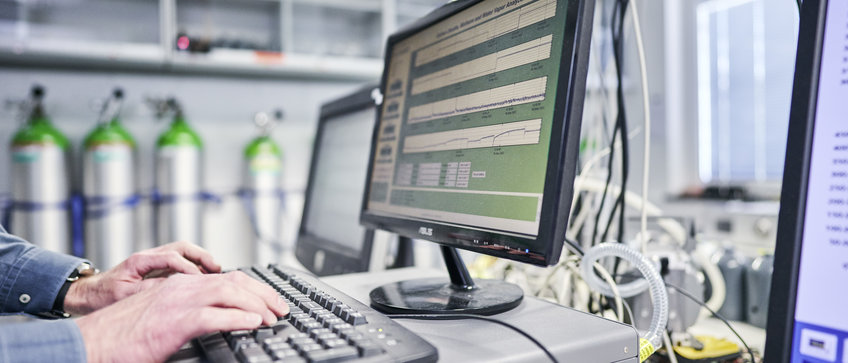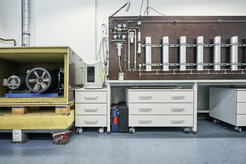
Reference gas production and calibration
The accuracy and consistency of greenhouse gas measurement data is fundamental for their scientific usability. To meet these requirements strict specifications were made for ICOS stations regarding their set-up and instrumentation. One component are reference materials that are needed to obtain precise concentration data from uncalibrated signals of the measuring instruments in the field. A crucial aspect of the ICOS calibration strategy is that these reference gases are provided for the entire measurement network from one central source that ensures the compatibility of all reference gases. This is the task of the central ICOS laboratory in Jena.
Calibration gas sets for ICOS stations
Sets with reference gases from natural air are produced for the two ICOS domains atmosphere and ocean. The ICOS atmospheric measurement network currently comprises 40 stations in 14 countries; for the ocean measurement network, 8 ships have been deployed as observatories to date. In the atmospheric network, a station set includes 5-6 compressed gas cylinders, and 3 reference gases are typically used on the ocean network ships. Additional reference gases are needed for quality control activities and instrument testing.
Production of reference gases
Reference gases consist of anhydrous, natural air. Its composition is specifically adjusted for the purpose to be used as a calibration standard with defined greenhouse gas concentrations.

Filling high pressure gas cylinders
The first step is to prepare the aluminum cylinders by heating them to 100°C (not higher!) and evacuating them to remove any residual solvents from the production process and to ensure a dry inner surface. They are then filled with dry atmospheric air to 100 bar, left to settle for 4 weeks and then vented again. An oil-free compressor is used to draw air from the roof of the building and pressurize it into the cylinders to 200 bar - in this process the air is thoroughly dried and may be passed through filters as required to reduce the concentrations of CO2, CH4, N2O and CO for the production of the raw gas mixture.
Adjusting mixing ratios

In order to encompass the range of possible atmospheric concentrations of the gases to be measured at the stations, it is necessary to use several reference gases covering this expected range. For this purpose, calculated amounts of pure gases or pre-mixtures of gases in air (CO2, CH4, N2O and CO) are added to each of the cylinders filled with the initial mixture in the previous step, after checking by a measurement. This procedure is carried out in several steps, if necessary.
Determination of concentrations
Following the production of the ICOS reference gases in pressurized gas cylinders, the primary task of our laboratory is to determine their concentrations of CO2, CH4, N2O and CO very accurately. At intervals of a few years and before the cylinders are emptied by use, these must be re-measured, since some trace gas contents can change slightly over time.
Calibration

The basis for the accurate calibration of the manufactured gases are own reference gases in the ICOS laboratory, calibrated by the international central laboratory, which is assigned by the World Meteorological Organization (WMO). This laboratory has determined concentration values for one set of primary reference materials very accurately and thereby ensures metrological traceability to the basic physical units of the International System of Units (SI). These primary reference standards cover a concentration range that span the atmospheric abundance of the respective trace gas. The set of these reference standards is referred to as the calibration scale. All measurements made under the WMO Global Atmosphere Watch program are linked to these scales. ICOS is a contributing network to WMO-GAW.
Advances in instrument technology, new findings of small changes in these primary reference standards, or perturbations from other components may require the WMO Central Laboratory to make corrections to the assigned concentration data of these primary standards. In order to distinguish greenhouse gas data that refer to concentration data valid at different points in time, they are described by a scale version name.
The ICOS Calibration Laboratory maintains a set of nine reference gases that are periodically recalibrated by the WMO Central Laboratory. This set of nine reference standards is used only to determine very accurately the concentrations of CO2 and CH4 or N2O and CO in the laboratory calibration standards by periodically repeated comparison measurements to extend its lifetime. Such the consistency of calibration results of the ICOS laboratory can be maintained also when laboratory standard sets need to be changed that are utilized for the daily calibration of the analyzers in the laboratory and are consumed within a few years.

Instrumental analysis
The measurements of reference gases are performed with two laser spectroscopic instruments, for CO2 and CH4 with a Picarro G2301 and for N2O and CO with a Los Gatos N2O/CO Analyzer EP. The basic principle of such optical analyzers is based on a concentration-dependent attenuation of a light pulse emitted by a laser. To minimize the influence of external factors (e.g. fluctuations in atmospheric pressure) on the measurement results, measurement intervals of at least three different days are generally used to determine the concentrations. The dryness of the gases is verified by measuring their residual moisture with a dew point mirror.
Data processing
The analyzed raw values are automatically transferred from the measuring instruments to the laboratory's in-house database for further processing. The workflow involves an automated validity check of the individual raw values, calibration of the raw data by the daily measurement of the laboratory standards, and aggregation of all individual values marked as valid. This average number must be validated by the laboratory manager after the quality control has been completed.
Quality control
To ensure the required data quality, quality control measurements of samples analyzed for this purpose only are performed with each measurement cycle. In addition, comparative measurements are performed on a regular basis:
- within the laboratory: measurement of air samples with different analytical methods
- internationally: exchange of air samples with other laboratories in round robin experiments.
The results of these quality controls as well as statistical evaluations of various parameters are included in the laboratory's annual quality control report, which estimates the overall uncertainty of the measurements.



